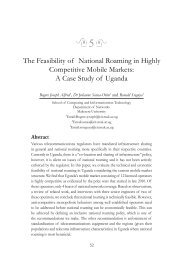Undergraduate Handbook - School of Computing and Informatics ...
Undergraduate Handbook - School of Computing and Informatics ...
Undergraduate Handbook - School of Computing and Informatics ...
Create successful ePaper yourself
Turn your PDF publications into a flip-book with our unique Google optimized e-Paper software.
• Laws <strong>and</strong> regulations affecting a small business in Ug<strong>and</strong>a: CAP <strong>and</strong> Local bye laws<br />
• Sources <strong>of</strong> information <strong>and</strong> assistance; Trade association <strong>and</strong> other non-governmental sources; Local, state,<br />
<strong>and</strong> federal governmental sources; Small business analysis<br />
• Description <strong>of</strong> a comprehensive business plan; Reason for preparing a business plan; Types <strong>of</strong> business<br />
plans; Form <strong>of</strong> business plan; Contents <strong>of</strong> a successful business plan.<br />
• Outline <strong>of</strong> a business plan: Preparation <strong>of</strong> an executive summary; Establishment <strong>of</strong> company strategy;<br />
Development <strong>of</strong> a marketing plan; Sales strategy; financial plan.<br />
• Completion <strong>of</strong> the business plan; Writing the plan; Outside review <strong>of</strong> the plan.<br />
• Social <strong>and</strong> Ethical Responsibility<br />
Reference Books:<br />
i. B. R. Barringer & R. D. Irel<strong>and</strong>, Entrepreneurship: Successfully Launching New ventures. Published by<br />
Pearson-Prentice Hall. 1st edition, 2006.<br />
ii. T. W. Zimmerer <strong>and</strong> N. M. Scarborough, Essentials <strong>of</strong> Entrepreneurship <strong>and</strong> Small Business Management.<br />
4th edition, 2005.<br />
BIS 3102 Human Computer Interaction (3 CU)<br />
Course Description: This course covers: Introduction to the interdisciplinary area <strong>of</strong> Human Computer Interaction<br />
(HCI); the underlying principles <strong>of</strong> psychology, computer science <strong>and</strong> ergonomics that influence theory <strong>and</strong> practice<br />
<strong>of</strong> HCI design <strong>and</strong> usage; specific topics will include: models <strong>of</strong> human information processing, organizational<br />
structures <strong>and</strong> socio-technical approaches to information system design; design principles for dialogue management;<br />
issues <strong>of</strong> systems user-ability; hypertext; natural language processing; virtual reality <strong>and</strong> multimedia applications.<br />
The course aims to provide students with knowledge <strong>and</strong> skills in human factors with respect to interactive s<strong>of</strong>tware,<br />
characteristics <strong>of</strong> design processes, principles <strong>and</strong> guidelines <strong>of</strong> interface design, virtual environments with respect<br />
to interfaces, corporate <strong>and</strong> business aspects <strong>of</strong> human computer interaction, interface aspects <strong>of</strong> response times <strong>and</strong><br />
presentation, interaction devices.<br />
Indicative Content: Conceptual systems models; Interface design <strong>and</strong> evaluation; Systems engineering <strong>and</strong> systems<br />
design factors; Assessments; S<strong>of</strong>tware tools; Virtual environments; Menus <strong>and</strong> dialogues; Comm<strong>and</strong> <strong>and</strong> natural<br />
languages; Interface devices; Response times; Complexity; Information attributes; Human factors <strong>and</strong> attributes;<br />
Tasks; Cognitive modelling; Function mapping; Hypermedia; Societal considerations <strong>and</strong> ethics <strong>and</strong> Internet/web<br />
considerations<br />
Reference Books:<br />
i. A. Dix, J. Finlay, G. Abowd, R. Beale, Human Computer Interaction, 2nd edition, Prentice Hall, 1997.<br />
ii. A. Sears <strong>and</strong> J. A. Jacko, The Human – Computer Interaction <strong>H<strong>and</strong>book</strong>, 2008.<br />
iii. H. Sharp, Y. Rodgers <strong>and</strong> J. Preece, Interaction Design: Beyond Human Computer Interaction, John<br />
Wiley & Sons; 2nd edition, 2007.<br />
CSC 3103 User Interface Design (4 CU)<br />
Course Description: The course introduces the principles <strong>of</strong> user interface development, focusing on design,<br />
implementation <strong>and</strong> evaluation. The course aims at providing the skills listed below to students: Developing<br />
efficient, flexible <strong>and</strong> interactive User Interfaces (UI); Provide ability to identifying system users, the tasks they<br />
want to carry out <strong>and</strong> the environment in which they will be working; Creating conceptual designs; Designing<br />
various kinds <strong>of</strong> UI, in particular graphical user interfaces (GUIs) <strong>and</strong> websites; evaluating UIs; Appreciation <strong>of</strong><br />
realities <strong>of</strong> developing usable UIs in an organization.<br />
Indicative Content: Usability; User-Centered Design; UI S<strong>of</strong>tware Architecture; Human Capabilities; Output<br />
Models; Conceptual Models <strong>and</strong> Metaphors; Input Models; Design Principles; Paper Prototyping; Constraints <strong>and</strong><br />
79

















